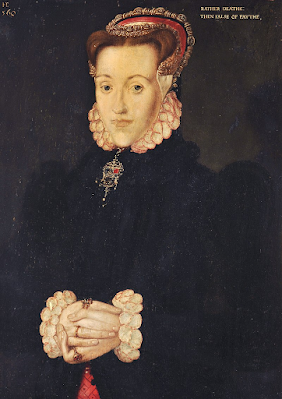Heroines of the Tudor World by Sharon Bennett Connolly was released on 15th June 2024 and I was sent an advance review copy since she and I share a publisher. My review is rather tardy because all summer I've been busy reading for the HWA (Historical Writers' Association) Crown Nonfiction Awards, as one of the judging panel. Hence I'm just now catching up with all the reading and writing from earlier in the year.
Still, better late than never, and what a treat this book was to read. Bennett Connolly has an easy, conversation style of writing which welcomes you from the opening pages and draws you into her story. This is her seventh book and her craft is polished and professional. She hints along the way that she has had to leave many of her heroines out of her story, and one senses the enormity of the research which she has diligently undertaken.
Concentrating on the stories of the women of the period, she does not isolate them. Focussing on her subjects but offering the wider context adds greatly to our understanding of the period and women's roles within it. To this end, she presents the stories thematically, rather than chronologically, but always with enough context so that the reader knows exactly where in the Tudor period these women lived - and died.
For it is certainly true that many of them met tragic and often violent ends, and one comes away with a sense that the Tudor period was one which was especially violent towards its high-ranking women. Lest we forget, this was an era where queens were executed, so there was little protection for those below the rank of royalty.
The fates of these women varied enormously and the stories range from those who demonstrate the Tudor ideal (Maria de Salinas, Lady Willoughby), to religious women such as Elizabeth Barton, known as the Nun of Kent, Anne Askew and Margaret Clitherow who met especially nasty ends. Even typing Margaret's name makes me shudder...
 |
| Portrait of Anne Askew |
Then we have royal mistresses, such as Bessie Blount, Mary Boleyn and of course her rather more famous/infamous sister Anne. I found this passage particularly insightful as so much has been written about Anne Boleyn; Bennett Connolly puts forward some interesting observations about her. Indeed she also offers an alternative view of the woman alleged to have been partly responsible for Anne's downfall: Jane Boleyn, Lady Rochford.
We've all heard of Lady Jane Grey, but her sisters also had sad lives, told in detail here, as are the fates of the French Queen Claude, Katherine Willoughby, and the tragic short life of Lady Mary Seymour, the child of Henry VIII's last wife, Kateryn Parr. The 'what if' was poignant here.
The overriding theme seems to be that so many of the women were not mistresses of their own fate, and we hear of Katherine Gordon, married to the pretender Perkin Warbeck and briefly imprisoned merely for having married him (she did not even know his true identity at the time of the wedding). And even if there might have been some evidence against her - planted, the author says - Margaret Pole, in her sixties, was certainly treated abhorrently and died in the most horrific way.
And yet, there were those who fought the system, and won. Of course there is a section on the woman who proved the men wrong - Elizabeth I - but Anne de Vere, Countess of Oxford, proved to be feistily litigious. Then there's Bess of Hardwick, of whom more perhaps is known.
The warrior women leave you in admiration at their courage: Catherine Sforza, Isabella of Castile, Grace O' Malley, and those who played high-stakes games, including Marie de Guise.
Of course there are the famous names, the familiar choices and as the author says, she couldn't not include Henry VIII's wives, but there too are women of whom most will not have heard, such as Helena Snakenborg. There's also a chapter on literary women, beginning with Margaret More .
As I said at the beginning of this review, it is clear that the author's research has been detailed and thorough, but it's used judiciously. The women speak to us from the pages, showing us how they swirled around the court, or the periphery thereof, making their marks, using their influence or, sadly, falling victim to the ambitions and machinations of powerful men. But throughout, what we get is a vivid picture of life in the upper echelons of Tudor society. Bennett Connolly's way with words shows us a picture of that world, colourful, vibrant, and violent.
Find more about Sharon Bennett Connolly on her website






No comments:
Post a Comment